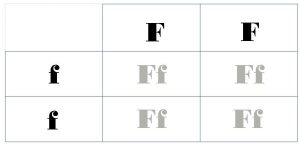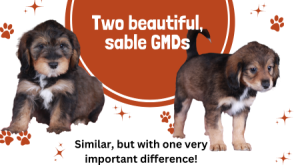
Find out how Furnishings can affect your choice of a Golden Mountain Doodle
With all that the Golden Mountain Doodle has going for it, there’s one thing that a potential GMD owner should look out for when selecting a puppy, if they have allergy concerns or want a non-shedding dog: furnishings. A good breeder will be sure to talk about your puppy’s furnishings and what to expect with your puppy as a result.
Most breeders will tell you that a fully furnished dog is considered hypoallergenic and non-shedding while an unfurnished dog is not. That is largely true, but not always accurate.
The poodle in the lineage, being curly-coated (with a single coat, which is more like hair than fur) is fully furnished and is considered hypoallergenic and non-shedding. On the other hand, the Bernese mountain dog and the retriever in the lineage are both unfurnished (double-coated and do shed). Genetically, the poodle is typically “FF” and the retriever and the Bernese are “ff.” Let’s look at the classic “Punnet Square” of genetics to see what happens when a fully-furnished poodle is bred with an unfurnished Bernese mountain dog or golden retriever:
100% of the offspring (what would be known as an F1 Bernedoodle or an F1 Goldendoodle) will likely be genetically “Ff,” which means they have a dominant and expressed “fully furnished” gene and a recessive (not expressed) “unfurnished” gene.
When we get into the next generation, crossing the Bernedoodle and the Goldendoodle to make the F2 Golden Mountain Doodle, we see that approximately 25% of the offspring in our scenario will be “ff,” which is unfurnished:
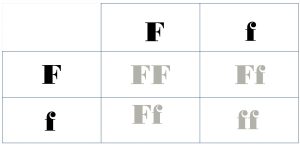
Multi-generational Golden Mountain Doodles (for example, a cross between two, F2 Golden Mountain Doodles) can potentially have an even larger percentage of unfurnished offspring. However, back-breeding with a poodle or having an F1b parent in the mix can improve the furnishings in the resulting gene pool.
Most breeders will tell you, if you want a hypoallergenic and non-shedding dog, you probably will not prefer an unfurnished puppy.
Complex Genetics
Unfortunately, shedding (or not) is more complex than just FF or ff, although furnishings can be a somewhat reliable indicator of whether or not a dog will shed. As one article from Embark explains, there are a number of genes that affect the level of shedding, and the reality is that a dog cannot be positively identified as “non-shedding” absent a genetic test.
The best course of action, if you are considering a Golden Mountain Doodle, is to talk to the breeder about any genetic testing that has been done for the parents, to see what the likelihood is for the puppies to shed (or not). Does the breeder note any shedding in the puppies? (Or, can you visit the puppies to see for yourself?)
“Fully Furnished”
As you can see in our genetics example above, most of the offspring in a typical litter of Golden Mountain Doodle puppies will be furnished. They will have the classic, Doodle “beard” and bushy brows. Fully furnished dogs also have fuzzy paws and hair growing on the bridge of the nose and over (or in front of) the eyes.
As an article from Animal Genetics points out, although shedding genes are actually not tied to furnishings, a fully furnished dog is less prone to shed, even if other genetic factors are present. This is why most breeders will recommend a fully furnished dog if you are looking for one that is considered hypoallergenic and non-shedding.
A fully furnished dog is not necessarily curly like a poodle. The coat gene is separate from the furnishing gene, so a fully furnished dog can have a straight, wavy, or curly coat and still be considered hypoallergenic and non-shedding.
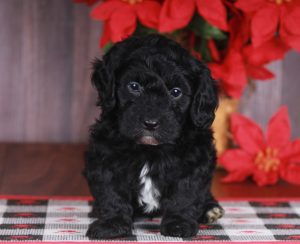
“Unfurnished”
Also known as “improper coat,” an unfurnished dog has the flat-muzzle appearance of the Bernese or the retriever. They will not have the classic, “bearded” Doodle look or the bushy brows. Hair growing over (or in front of) the eyes is another sign of Doodle furnishings, so this will be noticeably absent in the unfurnished. The hair will not be as fluffy on the feet, so you will be able to see an unfurnished puppy’s claws, whereas they will be pretty well covered up in a furnished puppy.
Although other genetic indicators may identify an unfurnished dog as low-shedding, most breeders will acknowledge that a certain degree of shedding should be expected from an unfurnished dog.
Don’t be fooled by a curly coat on an unfurnished dog. The gene for furnishings is entirely separate from the gene that determines whether the coat is flat/straight, wavy, or curly. Therefore, an unfurnished dog can have a body coat type that is wavy or curly, but may not show the other key features of furnishings.

“Weakly Furnished”
Fully furnished dogs in the parent line may produce “weakly furnished” puppies (typically, they carry an “improper coat” gene and can pass this trait along to their offspring). In this case, a puppy will be considered fully furnished but will not usually have a full “beard” until a little later in development (sometimes, when the adult coat comes in, or perhaps even later).
Weakly furnished dogs are usually still considered hypoallergenic and will likely be no-to-low-shedding. If you have severe allergies or are very concerned about any level of shedding, you may want to opt for a wavy or curly-coated Doodle that is not weakly furnished. On the other hand, with regular grooming, even a low-shedding dog may not put off a noticeable level of fur on clothing or in the environment.
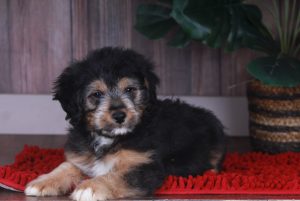
The Bottom Line
Both Sonoran Standard and Moonstruck Bernedoodles offer good descriptions of furnished versus unfurnished and more information on the specific genetics affecting your puppy’s final appearance and potential for shedding. Other articles and information referenced here can give you a good idea of the questions to ask and what to look for if you are hoping for a “hypoallergenic and non-shedding” Golden Mountain Doodle.
But remember: there is really no such thing as a non-shedding dog. The best you can do is look for the genetic mix that gets you closest to that goal. The presence or absence of furnishings is likely the best starting point and the most reliable indicator, but it is not the only determining factor.

